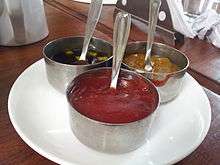Nutritional yeast


Nutritional yeast is a deactivated yeast, often a strain of Saccharomyces cerevisiae, which is sold commercially as a food product. It is sold in the form of flakes or as a yellow powder and can be found in the bulk aisle of most natural food stores. It is popular with vegans and vegetarians and may be used as an ingredient in recipes or as a condiment.[1]
It is a significant source of some B-complex vitamins and contains trace amounts of several other vitamins and minerals.[2] Sometimes nutritional yeast is fortified with vitamin B12.
Nutritional yeast has a strong flavor that is described as nutty, cheesy, or creamy, which makes it popular as an ingredient in cheese substitutes. It is often used by vegans in place of cheese,[3] for example in mashed and fried potatoes, in scrambled tofu, or as a topping for popcorn.[4]
In Australia, it is sometimes sold as "savoury yeast flakes." In New Zealand, it has long been known as Brufax. In the United States, it is sometimes referred to as "hippie dust", "nooch" or "yeshi", an Amharic name meaning "for a thousand". Though "nutritional yeast" usually refers to commercial products, inadequately fed prisoners of war have used "home-grown" yeast to prevent vitamin deficiency.[5] Nutritional yeast is different from yeast extract, which has a very strong flavour and comes in the form of a dark brown paste.
Commercial production
Nutritional yeast is produced by culturing a yeast in a nutrient medium for several days. The primary ingredient in the growth medium is glucose, often from either sugarcane or beet molasses. When the yeast is ready, it is deactivated with heat and then harvested, washed, dried and packaged. The species of yeast used is often a strain of Saccharomyces cerevisiae.[6] The strains are cultured and selected for desirable characteristics and often exhibit a different phenotype from strains of S. cerevisiae used in baking and brewing.
Acetaldehyde is the hazardous air pollutant emitted in the largest quantities from the manufacturing of nutritional yeast.[7]
Nutrition
Nutritional values for nutritional yeast vary from one manufacturer to another. On average, two tablespoons (about 30 ml) provides 60 calories with 5 g of carbohydrates (four grams of which is fiber). A serving also provides 9 g of protein and is a complete protein, providing all nine amino acids the human body cannot produce. While fortified and unfortified nutritional yeast both provide iron, the fortified yeast provides 20 percent of the recommended daily value, while unfortified yeast provides only 5 percent. Unfortified nutritional yeast provides from 35 to 100 percent of vitamins B1 and B2.
Because nutritional yeast is often used by vegans, who need to supplement their diets with vitamin B12, there has been confusion about the source of the B12 in nutritional yeast. Yeast cannot produce B12, which is only naturally produced by some bacteria. Some brands of nutritional yeast, though not all, are fortified with vitamin B12. When fortified, the vitamin B12 (commonly cyanocobalamin) is produced separately and then added to the yeast.[8][9]
Although some species of bacteria that can produce B12 could potentially grow along with S. cerevisiae in the wild, commercially produced nutritional yeast is grown in controlled conditions that would normally not allow those bacteria to grow. Therefore, nutritional yeast is not a reliable source of B12 unless it is fortified.
Glutamic acid
All inactive yeast contains a certain amount of glutamic acid because when the yeast cells are killed, the proteins that compose the cell walls begin to degrade, breaking down into the amino acids that originally formed the proteins. Glutamic acid is a naturally occurring amino acid in all yeast cells, as well as in vegetables, fungi, and animals, and is commonly used as a flavor enhancer in cooking in its sodium salt form, monosodium glutamate.
See also
References
- ↑ Brown, Elizabeth (25 April 2009). "Singing the praises of nutritional yeast". Santa Monica Daily Press. Retrieved 7 October 2012.
- ↑ "Large flake nutritional yeast". USDA Branded Food Products Database. United States Department of Agriculture. Retrieved 26 September 2018.
- ↑ Stepaniak, Joanne (2003). The Ultimate Uncheese Cookbook (10th ed.). Summertown, Tenn.: Book Pub. Co. p. 32. ISBN 978-1-57067-151-7.
- ↑ Wasserman, Debra (1997). Conveniently Vegan (Revised. ed.). Baltimore, Md.: Vegetarian Resource Group. p. 29. ISBN 978-0-931411-18-2.
- ↑ J G Lee HARUKOE (HARUKU)
- ↑ Industrial Exploitation Of Microorganisms. New Delhi: I.K. International Pub. House. 2010. p. 6. ISBN 9789380026534.
- ↑ "Manufacturing of Nutritional Yeast: National Emission Standards for Hazardous Air Pollutants (NESHAP)". United States Environmental Protection Agency. Retrieved 2018-03-05.
- ↑ "Nutritional Yeast". bestnaturalfoods.com. Retrieved 14 December 2011.
- ↑ "THE 5 STEPS IN MANUFACTURING NUTRITIONAL YEAST". Lessafre Human Care. Retrieved 14 December 2011.
